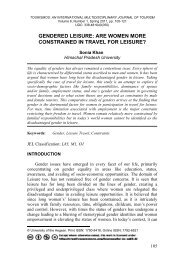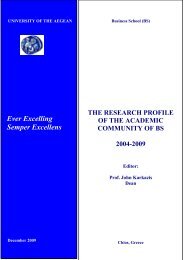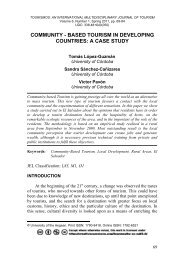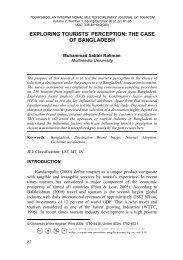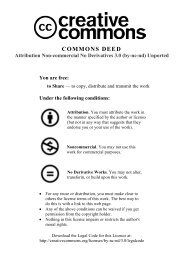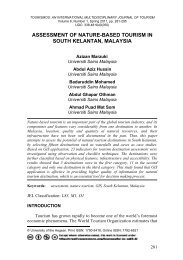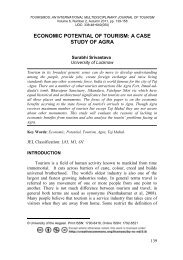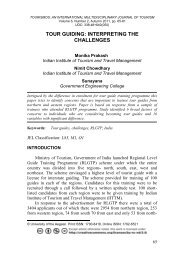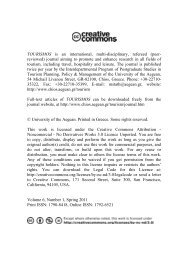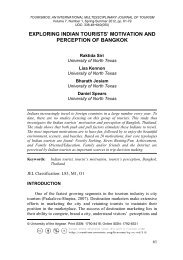is 'malaysia truly asia'? forecasting tourism demand from asean ...
is 'malaysia truly asia'? forecasting tourism demand from asean ...
is 'malaysia truly asia'? forecasting tourism demand from asean ...
You also want an ePaper? Increase the reach of your titles
YUMPU automatically turns print PDFs into web optimized ePapers that Google loves.
Loganathan Nanthakumar, Thirunaukarasu Subramaniam & Mori KogidMalaysia as a tour<strong>is</strong>t destination. Lower real exchange rate and politicalstability made Malaysia as an affordable tour<strong>is</strong>t destination. Malaysia <strong>is</strong>also well known for its ‘green tour<strong>is</strong>m’ with attractive tropicalenvironment; ‘blue tour<strong>is</strong>m’ with beautiful beaches and <strong>is</strong>lands; h<strong>is</strong>toricaland culinary attraction; diverse culture; diverse ethnic food (see forexample Josiam, Sohail & Monteiro, 2007); world-class hotels andresorts; and excellent shopping places. East Asia, which include Japan,Korea, China and Taiwan, including ASEAN (Association of SoutheastAsian Nations) countries are Malaysia’s major tour<strong>is</strong>t market, with amarket share of 75% of the overall international tour<strong>is</strong>t arrivals toMalaysia in 2010. Singapore, Indonesia and Thailand are three majortour<strong>is</strong>m source markets for Malaysia, with a total share of 60% <strong>from</strong> thetotal international tour<strong>is</strong>t arrivals to Malaysia in 2010. Th<strong>is</strong> phenomenaconcurs with ‘Malaysia <strong>is</strong> Truly Asia’ tagline promoted by Tour<strong>is</strong>mMalaysia. In spite of the phenomenal growth in inbound tour<strong>is</strong>m <strong>from</strong>ASEAN region, little research has been undertaken on these markets toevaluate their contributions to Malaysia’s inbound tour<strong>is</strong>m industry. Theinternational tour<strong>is</strong>m can be estimated in terms of the number ofinternational tour<strong>is</strong>t arrivals. Meanwhile, domestic tour<strong>is</strong>m generally <strong>is</strong>not considered for most of empirical analys<strong>is</strong> purposes. The WorldTour<strong>is</strong>m Organization predicted that there will be 1.6 billion internationaltour<strong>is</strong>t arrivals worldwide by 2020 and that these tour<strong>is</strong>ts are alsoexpected to spend over two trillion US dollars (WTO Report, 2010).Thus, the d<strong>is</strong>cussion of th<strong>is</strong> paper <strong>is</strong> organ<strong>is</strong>ed as follows. The secondsection of th<strong>is</strong> paper will d<strong>is</strong>cuss the selected literature review. The thirdsection focuses on methodology used. The fourth section touches onempirical findings and the final section concludes.LITERATURE REVIEWAlong with the phenomenal growth in <strong>demand</strong> for tour<strong>is</strong>m worldwideover the past two decades, there <strong>is</strong> also a growing interest in tour<strong>is</strong>mresearch. The literature on modelling and <strong>forecasting</strong> tour<strong>is</strong>m <strong>demand</strong> <strong>is</strong>numerous with various type of empirical analys<strong>is</strong>. Some of theresearchers applied cross-sectional data, but most of tour<strong>is</strong>m <strong>demand</strong><strong>forecasting</strong> used pure time-series analytical models. One of the importanttime-series modelling used in <strong>forecasting</strong> tour<strong>is</strong>m <strong>demand</strong> <strong>is</strong> ARIMAmodelling, which <strong>is</strong> specified based on standard Box-Jenkins method, afamous modelling approach in <strong>forecasting</strong> <strong>demand</strong>. Many studies haveapplied th<strong>is</strong> methodology, such as Chu (2008a), Lee, Song and Mjelde(2008), Coshall (2009), Wong et al. (2007), Akal (2004), Preez and Witt368



